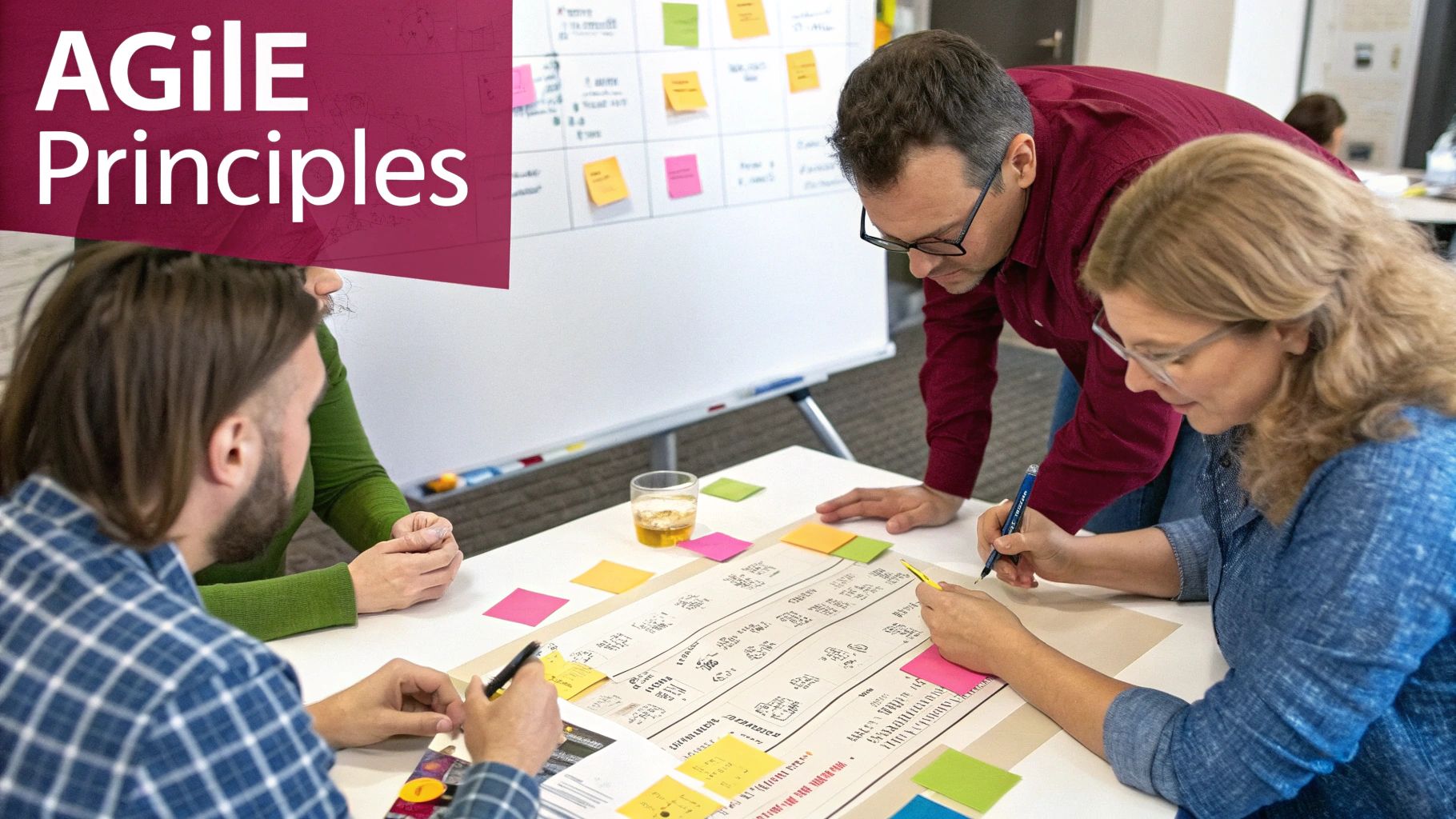Agile mobile app development is all about building an application through a series of short, focused cycles. This collaborative method lets your team react almost instantly to user feedback and shifts in the market, making sure the final product actually hits the mark. It’s a world away from traditional development, where every single detail has to be planned out before any real work begins.
Why Mobile App Development Demands Agility
Trying to keep up with the mobile market can feel like you’re trying to hit a moving target in the dark. Consumer tastes change on a dime, new devices pop up constantly, and your competitors are launching new features what feels like every other day. In this kind of environment, the old “plan-it-all-at-once” Waterfall methods just can’t hang. They’re too slow, too inflexible, and frankly, too risky.
To put it into perspective, a traditional approach is like building an entire car from scratch based on a blueprint, only to find out nobody wants that model by the time it rolls off the assembly line months later. You design, build, and test the whole app before a single user lays eyes on it. By then, the market may have already zoomed past you.
Traditional vs. Agile Mobile Development at a Glance
The difference between these two philosophies is stark. One is a linear, one-shot process, while the other is a continuous loop of building, testing, and learning. This table breaks down the core distinctions in the context of creating a mobile app.
| Aspect | Traditional (Waterfall) Approach | Agile Approach |
|---|---|---|
| Planning | All requirements defined upfront in a massive, rigid plan. | High-level planning at the start, with detailed planning done in short cycles (sprints). |
| Execution | Follows a strict, sequential order: Design > Build > Test > Deploy. | Work is done in iterative cycles, with design, building, and testing happening concurrently. |
| Delivery | One large delivery at the end of the project. | Features are delivered incrementally at the end of each cycle, providing continuous value. |
| Feedback | User feedback is gathered only after the final product is launched. | Feedback is collected constantly from users and stakeholders throughout the process. |
| Change | Changes are difficult, expensive, and actively discouraged. | Change is expected and welcomed, allowing the team to pivot based on new insights. |
| Risk | High risk of market irrelevance or project failure due to the long, blind development cycle. | Risk is minimized by testing ideas and features with real users early and often. |
Ultimately, Agile doesn’t just manage change; it thrives on it. It’s built on the understanding that you can’t possibly know everything on day one, so the process itself is designed to help you learn and adapt as you go.
The Pit Crew Mentality
Agile flips the old script completely. Think of an Agile team as a high-performance pit crew at a racetrack. They don’t just set up the car before the race and hope for the best. They are on standby, ready to make lightning-fast, precise adjustments during the race—changing tires, tweaking the aerodynamics, and refueling in seconds. They use real-time data to keep the car in the running.
That’s exactly how Agile teams operate. They build and release features in short, focused bursts called sprints. This iterative process brings a few major wins:
- Rapid Feedback: You get feedback on working parts of the app early and often, not just at the very end.
- Flexibility: If a competitor launches a game-changing feature or user data shows something isn’t working, the team can pivot in the very next sprint.
- Reduced Risk: By building in small pieces, you avoid sinking a huge amount of time and money into a massive project that might flop on launch day.
The real power of Agile is that it embraces change. It acknowledges that you can’t know everything at the start of a mobile app project and gives you a framework for learning and adapting along the way.
Thriving in a Multi-Billion Dollar Arena
The need for this kind of adaptability is driven home by the staggering size of the mobile industry. The mobile app market is projected to skyrocket to over $613 billion in global revenue by 2025. This massive growth isn’t just because more people are using apps—with the user count expected to hit 7.49 billion that same year. It’s also fueled by the intense demand for the kind of rapid, iterative development that only Agile makes possible. You can dive deeper into these app development statistics on DesignRush.com.
At the end of the day, choosing Agile is no longer a simple preference. For anyone serious about competing in the modern app economy, it’s a strategic necessity for survival.
Understanding the Agile Mobile Workflow
 To really get a feel for agile mobile app development, you have to look past the buzzwords and see how a team actually works day-to-day. The agile workflow isn’t some rigid rulebook; it’s a living system built for learning and adapting on the fly. It all boils down to a few core ideas that help turn a big, fuzzy concept into a working app that people genuinely love, piece by piece.
To really get a feel for agile mobile app development, you have to look past the buzzwords and see how a team actually works day-to-day. The agile workflow isn’t some rigid rulebook; it’s a living system built for learning and adapting on the fly. It all boils down to a few core ideas that help turn a big, fuzzy concept into a working app that people genuinely love, piece by piece.
Let’s follow a small, focused team. Their mission? To build a new photo-sharing feature for an existing social media app. Watching them work will show us the mechanics of the agile process in action, starting with the very heartbeat of the operation: the sprint.
The Power of Sprints
A sprint is simply a short, fixed period of time where the team commits to finishing a specific batch of work. These cycles usually last anywhere from one to four weeks, which sets a steady, predictable rhythm for development. For our photo-sharing team, they might agree on two-week sprints.
This structure is a game-changer. It stops projects from spiraling into endless, undefined timelines. It also forces the team to slice up a massive, daunting goal (like “build photo sharing”) into smaller, more manageable tasks that they can actually finish and test within that two-week frame. When each sprint ends, the team has something real and potentially shippable to show for their work.
Defining Work with User Stories
So, what does the team actually do during a sprint? They work on user stories. These aren’t dense technical specs; they’re short, simple descriptions of a feature, told from the user’s point of view.
Instead of creating a task that says, “Implement image upload API,” a user story frames the goal around a human need:
- As a social media user,
- I want to select a photo from my phone’s gallery,
- so that I can share it with my friends on the platform.
This simple format keeps everyone laser-focused on delivering value to the user. Our imaginary team might tackle just a few core stories in their first sprint: selecting a photo, cropping it, and posting it. All the other cool ideas, like filters or tagging, are intentionally put on the back burner for a future sprint. This discipline ensures the most essential stuff gets built first.
In agile mobile app development, user stories are the bridge between a technical task and a human need. They force the team to constantly ask, “Who are we building this for, and what problem are we solving for them?”
Continuous Feedback and Adaptive Planning
At the end of their two-week sprint, our team doesn’t just clock out and grab the next batch of work. They hold a sprint review. This is where they demo the working crop-and-post feature to stakeholders, the product manager, and maybe even a few real users. This is the continuous feedback loop in action.
What if the feedback is that the cropping tool feels clunky and confusing? This insight immediately feeds into adaptive planning. The original roadmap might have slated photo filters for the next sprint. But based on this new feedback, the team pivots. They now know it’s more important to refine the cropping experience than to add a new, shiny feature.
This is the superpower of the agile mobile workflow. The plan isn’t set in stone; it’s a living document that changes based on real data and user reactions. This cycle of sprinting, getting feedback, and adapting prevents the team from spending months building something that nobody wants or enjoys using. It’s all about building the right product, not just building the product right.
Choosing Your Agile Framework: Scrum vs. Kanban
Once your team is on board with going agile for mobile app development, you’ll quickly hit a fork in the road. Which framework do we actually use? There’s no single “best” answer here; it’s about finding the right fit for your team’s personality, the project’s demands, and your company’s overall rhythm. The two heavyweights you’ll hear about most are Scrum and Kanban.
Think of Scrum as the highly structured football coach. The coach maps out a precise set of plays (the sprint backlog) that the team needs to execute perfectly within a set time, say a two-week period (the sprint). The ultimate goal is to score a touchdown—releasing a new batch of features—at the end of that period. This highly disciplined approach is fantastic for projects with clear, ambitious release goals.
Kanban, on the other hand, is more like an expert air traffic controller. The main job isn’t to run a set play but to keep the planes (work) landing and taking off smoothly. The focus is on seeing the entire workflow, limiting how many planes are on the runway at once to prevent jams, and continuously getting things delivered. This makes it a great fit for teams handling maintenance, support, or a steady stream of smaller improvements.
Scrum: Structure and Discipline
Scrum is built around fixed-length iterations called sprints. Before any work kicks off, the team commits to a specific chunk of work from the product backlog. This creates a predictable rhythm of delivery, complete with formal roles like the Scrum Master, who keeps the process running smoothly, and the Product Owner, who prioritizes the work.
This structure comes with some real advantages:
- Predictability: Everyone, from stakeholders to executives, knows that a new set of working features will be ready for review at the end of every single sprint.
- Focus: Once a sprint starts, the team is protected from new requests. This allows them to zero in on the sprint goal without distractions.
- Rhythm: Daily stand-ups and sprint reviews build a consistent, disciplined pulse for the entire team.
This disciplined method has become a pillar of modern business. Agile adoption isn’t just for software anymore; it’s changing how entire companies operate, especially in mobile app development. By 2025, agile methods are expected to be used by 28% of traditional business operations and 20% of marketing teams, showing just how far its influence has spread. You can dig deeper into these agile trends and predictions on EasyAgile.com.
Kanban: Flow and Flexibility
Kanban is all about flexibility and seeing your work in motion. There are no prescribed sprints or rigid roles. Instead, tasks are pulled from a backlog onto a Kanban board, which usually has columns like “To Do,” “In Progress,” and “Done.”
A core rule in Kanban is to limit your Work in Progress (WIP). By capping the number of tasks allowed in the “In Progress” column, you prevent bottlenecks and keep work flowing at a steady, sustainable pace. This is incredibly effective for teams that juggle a continuous stream of tasks with shifting priorities, like bug fixes or small feature requests.
Here’s what a simple Kanban board, like one you might find on Trello, looks like: This visual board gives you an at-a-glance understanding of where every task is, who’s handling it, and where things might be getting stuck.
The core difference is simple: Scrum focuses on shipping a batch of work on a set schedule, while Kanban focuses on continuously moving individual tasks through a process as efficiently as possible.
So, how do you choose? A team building a brand-new app from the ground up with a defined feature list for version 1.0 would probably thrive with Scrum. But a team maintaining an existing app and responding to user-reported bugs would likely find Kanban’s continuous flow a much better match. Of course, many teams end up blending the two into a “Scrumban” hybrid to get the best of both worlds.
Agile Best Practices for React Native Teams
 Putting agile theory into practice is about more than just going to daily stand-ups. It’s about adopting smart, tactical habits that fit your technology. For teams building with React Native, the framework’s component-based nature is an almost perfect fit for the iterative rhythm of agile.
Putting agile theory into practice is about more than just going to daily stand-ups. It’s about adopting smart, tactical habits that fit your technology. For teams building with React Native, the framework’s component-based nature is an almost perfect fit for the iterative rhythm of agile.
When you lean into this synergy, you can turn abstract user stories into real, reusable pieces of your app with impressive speed. The secret is to think of every single component as its own mini-project within the larger sprint.
Embrace Component-Driven Development
React Native shines because it lets you build UIs out of isolated, reusable components. This is a massive advantage for agile teams, as it allows you to slice complex screens into small, manageable tasks that slot perfectly into a sprint.
Take a user profile screen, for example. In a more traditional workflow, building this screen might be one huge, intimidating task. But in an agile React Native project, it naturally breaks down into several smaller, independent user stories:
- As a user, I want to see my profile picture.
- As a user, I want to see my bio with a character counter.
- As a user, I want to see a grid of my latest posts.
Each of these can be built, tested, and reviewed as a self-contained unit. This doesn’t just make development faster; it helps you build up a library of assets you can reuse across the app, saving a ton of time down the road. That profile picture component you built? You can drop it into the chat header or a comment thread in a future sprint.
By aligning sprint tasks directly with UI components, you create a direct, traceable link between the product backlog and the actual codebase. This clarity simplifies progress tracking and makes sprint planning far more accurate.
Manage Platform-Specific User Stories
One of the classic headaches of cross-platform development is dealing with features that need different native code for iOS and Android. A smart agile process has to account for this without derailing the sprint.
A great way to handle this is to create platform-specific sub-tasks under a single parent story. Let’s say the story is to “Implement biometric login.” You can organize the work like this:
- Parent Story: As a user, I want to log in with my fingerprint or face.
- Sub-task (iOS): Integrate with Face ID/Touch ID APIs.
- Sub-task (Android): Integrate with the BiometricPrompt API.
This keeps the user-facing goal clear and unified while letting developers focus on the unique technical challenges of each platform. It also means the product owner can see the feature’s overall progress at a glance. You avoid cluttering your backlog with what looks like duplicate stories and maintain one source of truth for the feature.
Integrate Testing and Analytics Seamlessly
A truly agile team bakes quality assurance in from day one. In React Native, that means firing up tools like Jest and React Testing Library right inside the sprint. Instead of pushing testing to a separate phase, “done” for a component should mean it’s both built and tested.
Automated tests should be written right alongside the component code. This ensures every new feature is solid and that future updates don’t accidentally break something else—a critical practice for keeping up your pace.
On top of that, getting analytics in place early is the key to knowing if your agile iterations are actually working. Understanding user behavior lets you make data-driven calls for future sprints. For teams who want to get this right, exploring a guide on React Native analytics offers practical ways to track engagement and performance. That data feeds directly back into your planning, turning guesswork into a clear strategy and ensuring every development cycle delivers real value. This constant loop of building, measuring, and learning is what agility is all about.
Building an Agile CI/CD Pipeline for Mobile Apps
Being truly agile in mobile development isn’t just about how you organize your sprints—it’s about how fast you can turn those plans into something real in your users’ hands. This is where the agile philosophy gets its engine: the CI/CD pipeline.
Think of it as an automated assembly line for your app. It’s designed to completely get rid of the slow, error-prone manual work that always seems to kill a project’s momentum.
Continuous Integration (CI) and Continuous Deployment (CD) are two sides of the same coin, working together to create a smooth, uninterrupted path from a developer’s keyboard to a live user. Every time a developer commits new code, the CI server automatically builds the app and runs a whole suite of tests. If everything looks good, the CD part of the pipeline takes over and deploys the update.
The Automated Assembly Line
This automated process is the real secret behind a high-velocity agile mobile app development team. It’s a world away from the old, clunky methods where building, testing, and deploying were separate, manual jobs that could drag on for days.
With a well-oiled CI/CD pipeline, this entire sequence can happen in just a few minutes. It creates a powerful and rapid feedback loop:
- Code: A developer wraps up a bug fix or a new feature.
- Commit: They push that code to a shared repository, like GitHub.
- Build & Test: The CI server springs into action, automatically building the app and running tests to catch any regressions or errors.
- Deploy: Once the tests pass, the new version is pushed out.
This infographic paints a clear picture of how that CI/CD process flows, from the initial code commit all the way to final deployment.
The magic here is the hands-off automation. It’s what guarantees you get both consistency and speed, every single time you ship.
Sidestepping the App Store Bottleneck
For mobile teams, the biggest speed bump in this entire pipeline has always been the dreaded app store review process. This is exactly why tools that enable over-the-air (OTA) updates, like CodePushGo, have become such a critical part of the modern agile toolkit. They slot right into the deployment stage of your CI/CD pipeline.
Instead of submitting every little update to Apple or Google for review, you can push a ton of changes—especially to your JavaScript code in a React Native app—directly to your users’ devices.
An OTA update service acts as the final, crucial link in an agile CI/CD pipeline for mobile. It lets teams fly past the review delays for compatible updates, so they can fix bugs and ship features in minutes, not days or weeks.
This ability to deploy instantly is the perfect partner for the core agile principle of responding quickly to change. The market is absolutely exploding, with some projections showing the mobile app development sector will swell from $195.7 billion in 2023 to a staggering $606.1 billion by 2032. To even have a chance in such a fast-moving field, you need the kind of speed that only an automated OTA pipeline can give you. For more on this, check out these mobile app development trends from Bamboo Agile.
This is a great example of how a tool like CodePushGo fits right into your workflow, letting you manage release channels for different environments like production and staging.
A dashboard like this gives you fine-grained control over which users get which update, turning every deployment into a deliberate, strategic move.
For teams aiming to make their updates completely invisible to the user, you can learn more about automatic app updates and see how they fit into a modern development strategy. By bringing these tools into your process, you’re not just automating a few steps—you’re turning your CI/CD pipeline into a powerful engine for genuine agile delivery, making sure you can get value to your users at the speed the market demands.
Common Questions About Agile Mobile App Development
 Even teams who are eager to embrace agile often run into a few common myths and practical questions that can cause them to hesitate. Getting clear on these points is the first step toward building the confidence your team needs for a smooth transition into agile mobile app development. Let’s tackle some of the questions I hear most often.
Even teams who are eager to embrace agile often run into a few common myths and practical questions that can cause them to hesitate. Getting clear on these points is the first step toward building the confidence your team needs for a smooth transition into agile mobile app development. Let’s tackle some of the questions I hear most often.
How Do You Manage Fixed Deadlines in Agile?
This is a big one. While agile is celebrated for its flexibility, it absolutely works with real-world constraints like hard deadlines and fixed budgets. The secret lies in what you choose to make flexible. In agile, the variable isn’t the timeline or the cost—it’s the scope.
When faced with a firm deadline, the team’s first job is to define a Minimum Viable Product (MVP). This isn’t a watered-down version of the app; it’s the core set of features that delivers real value to users right from the start. Sprints are then laser-focused on building out that core functionality, ensuring you ship a valuable, working product on time, even if some of the “nice-to-have” features get moved to a later release.
With agile, a fixed deadline doesn’t force you to rush. It forces you to prioritize ruthlessly. The aim is to deliver the most impactful features within the given timeframe, guaranteeing a worthwhile outcome.
Can Agile Work for a Small Team or Solo Developer?
Absolutely. Agile isn’t just for massive corporate teams; its principles scale down beautifully. For a small team or even a solo developer, a simple framework like Kanban can be a game-changer for visualizing tasks, limiting work-in-progress, and keeping your focus sharp.
You don’t need all the formal ceremonies and roles of Scrum, which can feel like overkill for one or two people. Instead, you adopt the core ideas: build in small increments, get feedback from real users as early as possible, and be ready to adapt. This approach is incredibly effective for staying organized and avoiding the all-too-common trap of building features nobody actually needs.
What Is the Biggest Hurdle When Switching to Agile?
Without a doubt, the biggest challenges are almost always cultural, not technical. If a team is used to a rigid, top-down process where a big plan is handed to them, the mindset shift toward embracing uncertainty and constant collaboration can be tough.
Another common pitfall is what I call “Agile in Name Only.” This is when teams go through the motions—like daily stand-ups—but without the genuine feedback loops and iterative improvement that actually make agile work. To get past this, you need strong leadership commitment and a real grasp of the fundamentals. Reinforcing this new culture with solid technical habits, like the ones found in these software deployment best practices, can make a huge difference in tying quality and speed together.
Ready to make your agile pipeline truly instant? With CodePushGo, you can push updates directly to your users’ devices, bypassing app store reviews and delivering bug fixes in minutes. Explore CodePushGo today and accelerate your development cycle.




